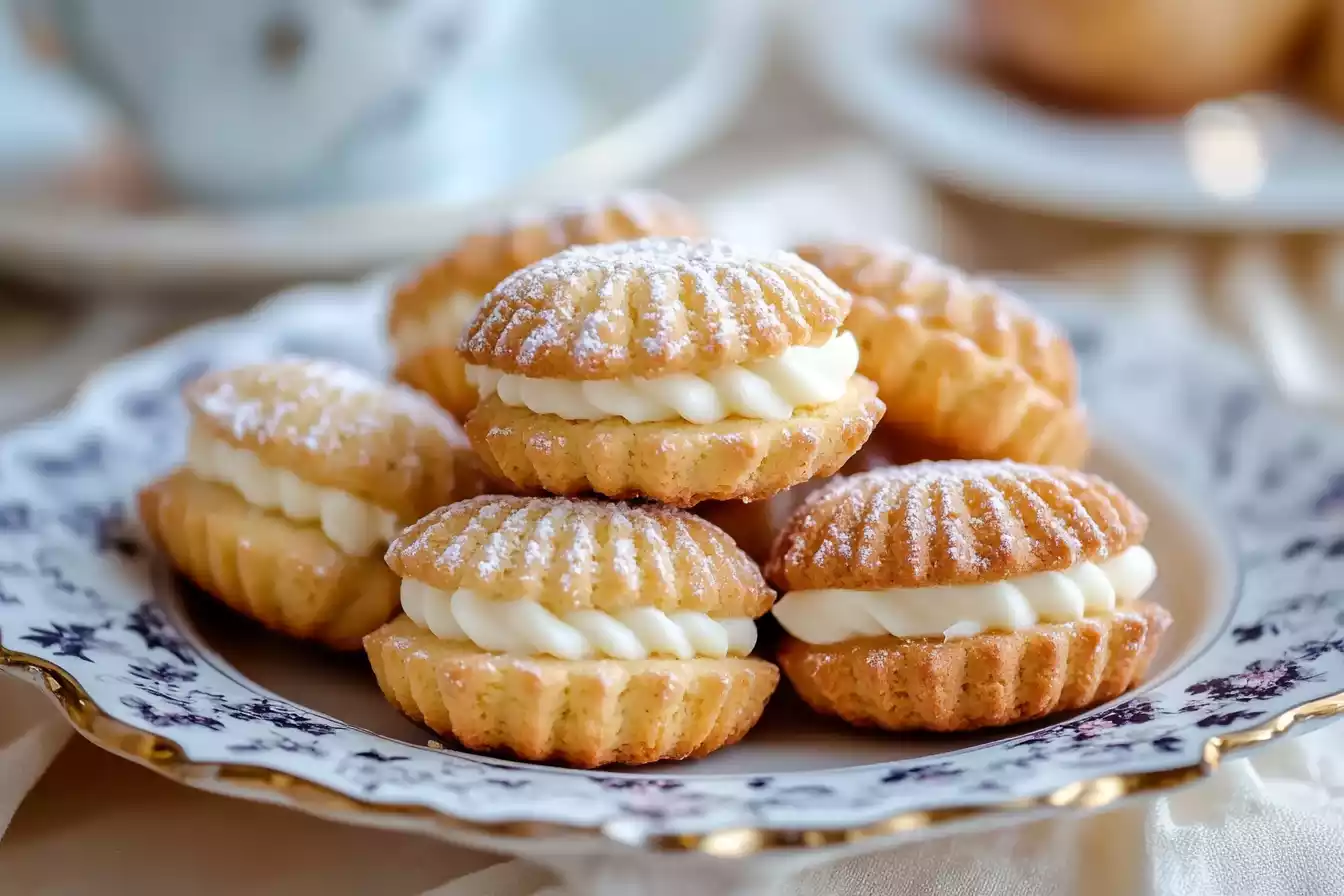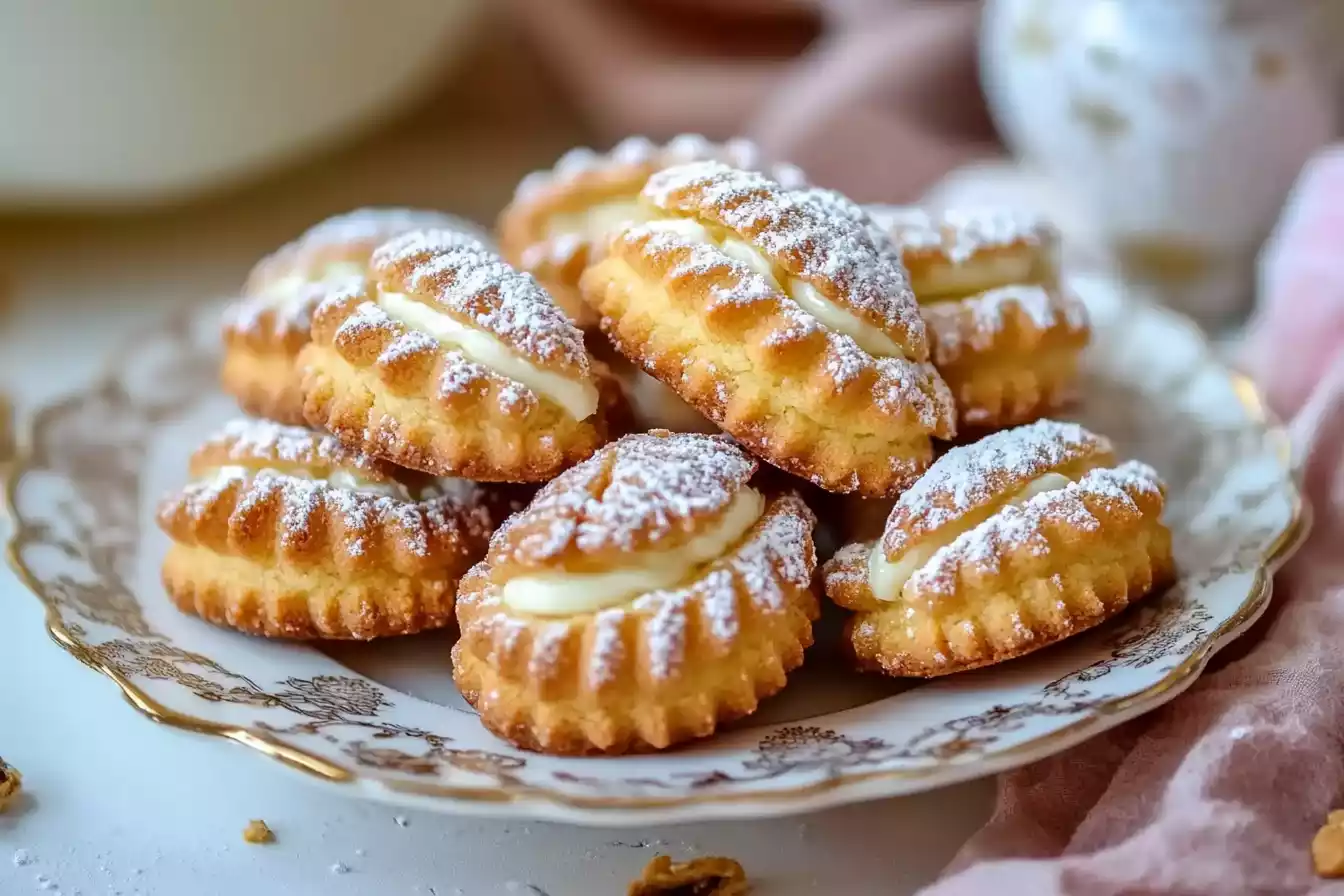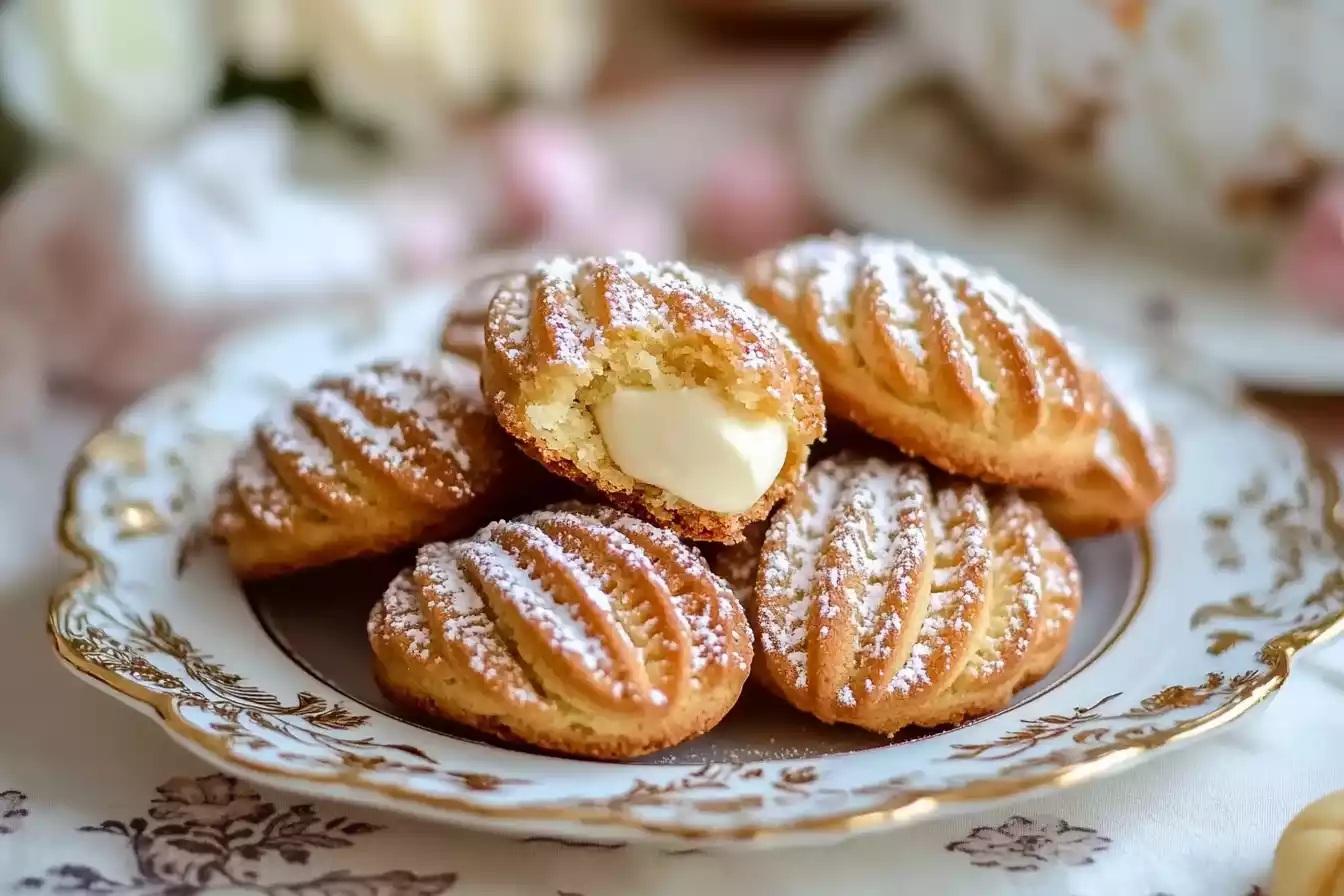Madeleine cookies, with their signature shell-like shape and delicate, buttery crumb, are a staple in French patisserie. These soft, sponge-cake-like delights have captured the hearts of cookie enthusiasts and home bakers worldwide. Originating in the Lorraine region of France, these elegant cookies are as much a work of art as they are a treat for your taste buds. While traditional recipes have delighted countless generations, adding cream introduces a rich, luxurious twist that elevates Madeleines to new heights.
If you’ve been wanting to up your cookie-baking game, this comprehensive guide will walk you through everything you need to know about creating perfect, cream-infused Madeleine cookies—from understanding their traditional origins to mastering advanced techniques.
A Brief History of the Madeleine Cookie

Madeleine cookies (also spelled “Madeleine”) are a hallmark of French baking, steeped in history and tradition. Their origins can be traced back to the 18th century in the town of Commercy, situated in France’s Lorraine region. Legend has it that the cookies were named after a young servant, Madeleine Paulmier, who baked them for King Stanislas Leszczyński. The king was so enchanted by their taste and simplicity that he popularized them throughout France.
Today, Madeleine cookies symbolize elegance and refinement, often found in high-end patisseries and tea rooms. Known for their distinctive shell shape—achieved by baking them in specialty pans—these cookies have a soft yet springy texture and a subtle buttery flavor, often enhanced with a touch of lemon or vanilla.
Cream-Infused Madeleine Cookies: A Decadent Twist
Traditional Madeleines are rich and satisfying, but when you introduce cream into the batter, you’re creating a cookie masterpiece. Cream adds a level of indulgence that takes the classic recipe to the next level by altering the texture and flavor profile in delightful ways.
Why Use Cream in Madeleine Cookies?
Cream serves as a tenderizer in baked goods, yielding a crumb that is softer and more melt-in-your-mouth than traditional recipes. It also introduces subtle richness, balancing the sweetness of the cookies with velvety undertones. Depending on the type of cream used—be it heavy cream, sour cream, or crème fraîche—you can create nuanced flavor variations.
Types of Cream and Their Effects
- Heavy (or whipping) cream: This classic choice enhances richness and fat content, creating a tender crumb and a subtle creaminess.
- Sour cream: Adds a slight tanginess that balances the sweetness, while also contributing to a moist and tender crumb.
- Crème fraîche: A sophisticated option that imparts a silky texture with just a hint of acidity, elevating the cookie’s complexity.
Experimenting with different creams can help you create Madeleine cookies that align perfectly with your flavor preferences.
Madeleine Cookies: Understanding Ingredients and Their Roles
To become a Madeleine master, it’s important to understand the role each ingredient plays in the final cookie. When working with cream, balancing the basic ingredients is essential to achieve the perfect texture and flavor.
The Core Ingredients:
- Flour: Provides structure and stability. All-purpose flour works well, but using cake flour can result in a finer, more delicate crumb.
- Butter: The soul of a good Madeleine cookie! Use high-quality, unsalted butter for a smoother, more nuanced flavor.
- Eggs: Essential for creating the leavening and structure in the batter. Room temperature eggs whip more effectively, leading to an airier batter.
- Sugar: Adds sweetness and contributes to the cookie’s lightly caramelized crust.
- Cream (the twist!): Introduces richness and moisture, ensuring every bite melts in your mouth.
- Flavorings (lemon zest, vanilla, etc.): Add dimension to the cookies. For a unique twist, try orange zest for a bright, citrusy aroma.
Selecting Quality Ingredients
Choosing the best-quality ingredients is critical. Seek out artisan butter, fresh farm eggs, organic sugar, and high-fat cream for the most flavorful results. Remember, the better the ingredients, the more impressive the final product.
Essential Equipment for Baking Perfect Madeleine Cookies

While Madeleines require minimal equipment, investing in a few key tools will ensure consistent results and enhance your baking experience.
Must-Have Tools for Madeleine Cookies:
- Madeleine Pan: The hallmark of Madeleine cookies is their signature shell-like shape, achieved through the use of a specialized Madeleine pan. Non-stick or metal pans with deep ridges are ideal for ensuring the cookies bake evenly with a beautiful golden-brown finish. Silicone pans can also be used but may result in slightly less crisp edges. A good Madeleine pan is key to achieving that classic look and texture.
- Mixing Bowls and Whisks: Large mixing bowls and sturdy whisks are essential tools for combining ingredients effectively. The batter for Madeleines needs to be mixed gently and evenly to avoid overmixing, which can lead to dense cookies. Using a whisk allows you to incorporate air, helping to create the light, fluffy texture Madeleines are known for.
- Measuring Instruments: Precision is critical when baking Madeleines, as even slight inaccuracies can affect the result. A reliable kitchen scale ensures ingredient weights are exact, while measuring cups and spoons help with smaller quantities. Proper measurements ensure the batter has the right consistency and flavor every time.
- Offset Spatula or Spoon: These tools are perfect for spreading the batter into the pan molds. An offset spatula allows for precise spreading, ensuring each mold is evenly filled for consistent baking. A spoon can also be used, but attention to detail is needed to avoid uneven cookies.
- Cooling Rack: Proper cooling is crucial to preserving the texture of Madeleines. A cooling rack allows air to circulate around the cookies, ensuring they cool evenly and preventing soggy bottoms. Removing them from the pan promptly and cooling them properly also helps maintain their delicate structure and flavor.
Choosing the Right Pan
Not all Madeleine pans are created equal! Opt for a high-quality, metal pan with a non-stick coating for ease of release. Silicone pans are another option, though they may yield slightly softer edges.
Mastering the Technique for Flawless Madeleine Cookies
Madeleines are deceptively simple to make, but there is an art to achieving their perfect texture and puffed “hump.” Here’s how to do it:
- Creaming Butter and Sugar: This is where the magic begins. Beating butter and sugar together creates the foundational fluffiness for your batter. The process incorporates air, resulting in a lighter, airier texture for your finished cookies. Don’t rush—spend a few extra minutes on this step to ensure the batter is well-aerated and smooth.
- Adding Eggs and Cream: Gradually add room-temperature eggs, one at a time, along with the cream. Using room-temperature ingredients is key to creating a smooth, cohesive batter that won’t curdle. Beat each addition just until combined to avoid overmixing, which could impact the texture of your cookies.
- Folding in Dry Ingredients: Gently fold in the sifted flour and other dry ingredients using a spatula. Be careful not to overmix; this step is all about maintaining the airy consistency built during creaming. Overworking the batter can develop too much gluten, leading to dense, heavy cookies instead of light, tender treats.
- The Chill Factor: Once your batter is mixed, it’s essential to let it rest in the refrigerator. This step is non-negotiable! Chilling firms up the batter, making it easier to work with, and allows the flavors to meld together beautifully. It also ensures the batter is thick enough to create the signature hump during baking.
- Filling the Pan: When the batter is ready, use a piping bag or an offset spatula to neatly scoop it into your pan molds. Make sure each mold is evenly filled, as this guarantees uniform baking and a professional look. A little precision here goes a long way in achieving picture-perfect cookies.
- Baking to Perfection: Preheat your oven thoroughly to ensure even heat distribution—an essential step for consistent results. Bake your cookies until the edges turn a light golden brown and the iconic hump forms in the center. Keep a close eye on them, as overbaking can dry them out, while underbaking may leave the centers too soft. Let them cool slightly before removing them from the molds to maintain their shape.
Madeleine Cookies: Creative Flavor Variations
Madeleine cookies’ simplicity makes them a perfect canvas for experimentation. Try these variations to bring new dimensions to your cookies:
- Chocolate: Add cocoa powder or dip cooled cookies in melted chocolate.
- Nutty: Incorporate finely ground nuts, like almonds or pistachios, into the batter.
- Citrusy: Add orange or grapefruit zest for a fresh twist.
- Spiced: Introduce warm spices, such as cinnamon or cardamom, for a cozy flavor profile.
- Extracts: Swap vanilla for almond or rose extract for a fragrant difference.
Remember, balance is key! Avoid overpowering the delicate flavor of the cookie base.
Madeleine Cookies: Troubleshooting Common Issues
Madeleines are sensitive cookies, and small deviations can lead to issues. Here’s how to troubleshoot:
- Flat Cookies: Ensure the batter is thoroughly chilled, and always use a preheated oven.
- Uneven Baking: Rotate the pan halfway through baking for consistent browning.
- Sticking to the Pan: Grease your pan generously, and dust with flour or sugar to create a non-stick barrier.
- Tough Texture: Avoid overmixing the batter or overbaking the cookies.
Serving and Presentation Ideas
Madeleine cookies pair beautifully with beverages like tea, coffee, or hot chocolate. For something more indulgent, serve them alongside ice cream or lightly dusted with powdered sugar.
For gifts or special occasions, consider packaging Madeleines in elegant boxes or wrapping them in decorative parchment paper. Their unique shell shape makes them a stunning addition to dessert platters.
The Science Behind Baking Madeleine Cookies

The magic of Madeleines lies in the science of baking. From gluten development to the Maillard reaction, every step contributes to their characteristic texture and flavor:
- Gluten Development: Minimal mixing limits gluten formation, which keeps the cookies soft and tender instead of tough or chewy. Overmixing can lead to a denser texture, so a gentle hand is key.
- Maillard Reaction: The light golden crust on cookies is a result of the Maillard reaction, a chemical process where sugars and proteins interact under heat. This not only gives cookies their appealing color but also enhances the flavor by creating rich, caramelized notes.
- Hump Formation: Allowing the batter to cool and rest before baking helps create structure and tension. This ensures the batter has enough resistance to rise properly in the oven, forming the classic “hump” shape that gives cookies their characteristic look.
Rediscover Joy in Baking With Cream-Infused Madeleine Cookies
Madeleine cookies hold a special place in the hearts of baking enthusiasts—and now, with the addition of cream, these classic treats are more luxurious than ever. Whether you prefer traditional recipes or creative flavor profiles, cream-infused Madeleines offer endless opportunities for personalization and experimentation in your kitchen.
Get ready to wow your taste buds and impress your loved ones! Enjoy the delightful process of baking these elegant cookies and share the joy of a perfectly baked Madeleine with friends and family.
Print
🍋🍶 Madeleine Cookies with Cream 🥄✨
Description
Did you know that Madeleines were said to be the favorite treat of King Louis XV? These delicate, shell-shaped French cookies are buttery, light, and perfect with a cup of tea. Adding cream makes them even more tender and melt-in-your-mouth delicious!
Ingredients
- 🥚 2 large eggs
- 🍚 ½ cup (100g) granulated sugar
- 🍯 1 tbsp honey (for extra moisture & flavor)
- 🍦 ½ cup (120ml) heavy cream
- 🌾 1 cup (125g) all-purpose flour
- 🥄 1 tsp baking powder
- 🧈 ½ cup (115g) unsalted butter, melted & slightly cooled
- 🍋 1 tsp lemon zest (or vanilla extract for a classic taste)
- 🧂 Pinch of salt
Instructions
-
Prepare the batter 🏺
- In a bowl, whisk the eggs, sugar, and honey until light and fluffy.
- Stir in the heavy cream and lemon zest (or vanilla).
-
Mix the dry ingredients 🌾
- In a separate bowl, whisk together the flour, baking powder, and salt.
- Gently fold the dry ingredients into the egg mixture.
-
Add the melted butter 🧈
- Slowly incorporate the melted butter into the batter, mixing just until combined.
- Cover and refrigerate for at least 1 hour (chilling helps create the signature hump!).
-
Bake the Madeleines 🍪
- Preheat the oven to 375°F (190°C).
- Grease and flour a madeleine pan. Spoon about 1 tbsp of batter into each mold.
- Bake for 10-12 minutes, until golden with a small hump.
-
Cool & serve 🌟
- Let the madeleines cool for a few minutes before transferring them to a rack.
- Dust with powdered sugar for a finishing touch!
Notes
✨ Nutritional Information | Calories: 130 kcal | Carbs: 15g | Protein: 2g | Fat: 7g
🥄 Enjoy these delicate, creamy Madeleines fresh out of the oven! Perfect for tea time, breakfast, or an afternoon treat. What flavor would you try next—chocolate, orange, or almond? Let me know! 🍋🍶💕
Pinterest: Baking Successful Irresistible, And Luxurious Madeline Cookies Recipe Using Cream
Post Disclaimer
👩🍳 100% Real Recipes, Chef-Approved! 🔥
All the recipes you’ll find here at Choco Fever Dream are completely real, thoroughly tested, and approved by professional chefs to ensure accuracy, flavor, and reliability. While we may use AI-generated images to enhance your browsing experience, the food itself is always the real deal.
We do our best to keep everything up-to-date and trustworthy, but we can’t promise perfection—so please use your own judgment when cooking. Most importantly, have fun and enjoy the process!
Happy cooking! 🍽️💛
